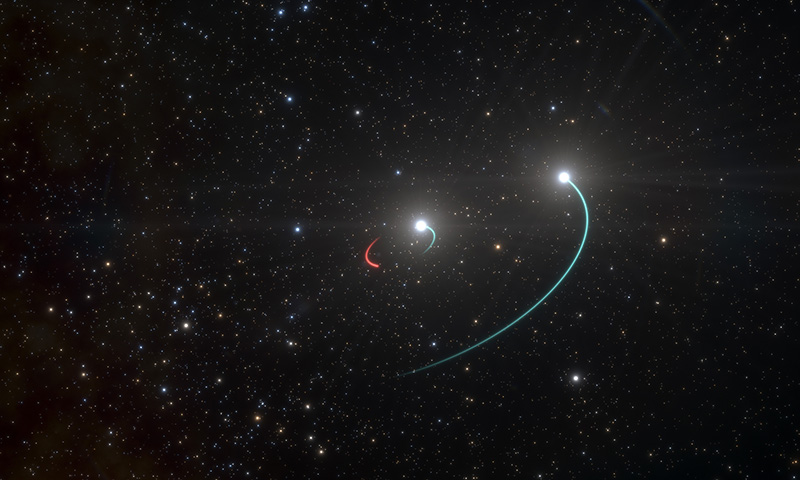Spectral observations of a star system 1,000 light-years away contain hints of an invisible, massive object.

ESO / L. Calçada
An international team of astronomers says that they’ve discovered the closest black hole to Earth — an invisible object dancing with two large, bright stars 1,000 light-years away.
Thomas Rivinius (European Southern Observatory, Chile) and colleagues found hints of the object in spectra of the star HR 6819, in the constellation Telescopium. HR 6819 is a Be star, a type of bright, bluish star that spins so fast, material whips off its equator to form a disk around the star. Previous work revealed that there’s a second bluish B-type giant star hidden in HR 6819’s light, detectable thanks to the fingerprints it leaves in the Be star’s spectra.
After disentangling the spectra of these two stars, the researchers see signs that the giant star is wobbling back and forth as it circles around with a third, unseen object every 40 days or so. Based on shifts in the star’s spectra and the average mass for B-type giant stars, the astronomers estimate that the unseen object contains more than 4 Suns’ worth of mass.
With that heft, the object would leave its own fingerprints in the spectra if it were a star. The team therefore concludes that the object is a black hole, invisible because it’s not gathering any gas from its neighbor. The researchers report the result May 6th in Astronomy & Astrophysics.
If real, HR 6819’s black hole would take first place as the closest black hole to Earth, knocking from the pedestal the accreting black hole in V616 Monocerotis, which lies about 3,300 light-years away based on Gaia measurements.
However, Hugues Sana (KU Leuven, Belgium) expresses misgivings. The team didn’t include their disentangling analysis in the paper (it’ll be published later). Although Sana agrees there are clearly two stars in the system — the Be star with wide spectral lines, the giant star with narrower ones — what if the B-type star isn’t the normal giant star that Rivinius and his colleagues assume it to be? That could mean the star’s mass is wrong and throw out the mass estimate for a third object.
Both Sana and Rivinius emphasize parallels between HR 6819 and the system LB-1. LB-1 made the news a few months ago when a different team announced that its B star appeared to pair with a black hole so massive that it violated rules for how these objects form. Quick rebuttals by other astronomers (including Sana) led to a downsizing. There’s now an ongoing debate about what’s really in the LB-1 system.
A preliminary analysis by Sana’s team suggests that LB-1 contains both a B star and a Be star — and no black hole. Rivinius’s team, on the other hand, has done its own observations of the LB-1 system, and he says they have evidence of an architecture exactly like what they’re proposing for HR 6819: a Be star, a B-type star, and a third, nonstellar object. Whatever is going on in LB-1, both Sana and Rivinius say, HR 6819 could be its twin.
References: T. Rivinius et al. “A Naked-eye Triple System with a Nonaccreting Black Hole in the Inner Binary.” Astronomy & Astrophysics. May 6, 2020.
 1
1









Comments
Michael
May 9, 2020 at 10:56 am
Thank you for another informative news article. I'm wondering what is the status of the possible black hole in the V Puppis system. It was supposedly 10 solar masses, and like HR6819, it was separated from the other two stars in a wide orbit, and was found via orbital mechanics instead of X-ray emission. The system is roughly about 1000 light years away from us. That would place it a lot closer than V616 Mon, yet V616 Mon is usually cited as the closest black hole. I'm guessing the assertion that V Puppis has a black hole has been ruled out. I know it was not a confirmed black hole. Here is a link to one of the original V Puppis papers:
Qian S.-B., Liao W.-P., Fernandez-Lajus E., 2008, ApJ, 687, 466
You must be logged in to post a comment.
You must be logged in to post a comment.